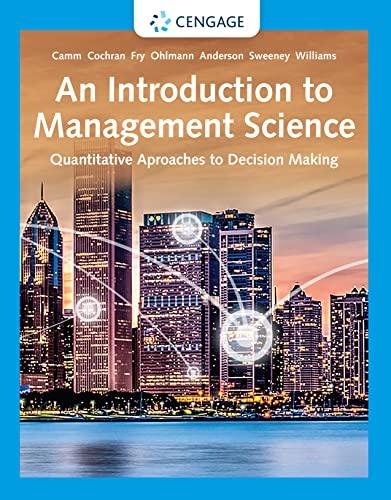Answered step by step
Verified Expert Solution
Question
1 Approved Answer
Produce a feasibility study report based on the info provided to you and your online searches. Tasks & Requirements Read provided information carefully to understand
Produce a feasibility study report based on the info provided to you and your online searches.
Tasks & Requirements
- Read provided information carefully to understand
- What does the projectApprenticed Business School (ABS)intend to do?
- What are the possible features of the ABS?
- What are the crucial factors, in your opinion, that determine the success or not of this project?
- Conduct an online search to collect related information based on your identification of crucial success factor(s)
- At least three research results are needed.
- The information collected must be from reliable sources.
- The information collected must be meaningful.
- The information collected must be properly cited.
- Gnerate a report to present your research and analysis results.
- The report must be well written without obvious mistakes (spelling, grammar, and structure)
- The report can use various formats, but must consist of the following parts.
- Your first impression when you first come across the projectis it workable or not?
- What have you done to validate this projectwhere have you searched? What topic have you searched for? What is your search sequence or logic?
- Your conclusion on the feasibility of the project based on your research datalist the reasons or rationale for supporting your conclusion.
- Have proper cited references
Context of the Project
- You are involved in a task force, which examines the feasibility of a new project. All information provided to you for this project is confidential.
- The project aims to establish a new business school called Apprenticed Business School (ABS).
- The ABS intends to graduate proved business doers and managers through combining on-job training and academic training innovatively.
- In the proposed ABS, students will spend half time working in a businessrotating in different positions and the other half time attending lectures, conducting self-study, and taking tests.
- From level 1 to level 4, the curriculum is designed to develop students' capacity of "know how," "know why," "know change/create," and "know lead/control."
- First-year students will be managed & mentored by Sophomores, Sophomores by Juniors, and Juniors by Seniors.
- Four academic years will be condensed into three calendar years due to no summer and winter breaks, as the real business does.
- In the proposed ABS, instructors' roles are two folds. One is to help students understanding the linkage between daily work and business knowledge and enhance students' self-learning capability. The other is to assist the management of the business.
- The ABS target young adults including traditional high school graduates (both college oriented and non-college oriented) working adults, and military veterans.
- Students will earn (starting at minimum wage with an annual raise) when they work. They will rotate systematically through different jobs in four major areas:
- Production & development
- Accounting & finance
- Marketing & promotion
- Logistics & HRM
- Academic learning in the ABS will be conducted in two forms. One is group learning facilitated by a learning coach. The other is individual learning through a smart learning portal.
- The proposed ABS will belong to the category of the private for-profit university. It aims to attract investors by issuing shares and will generate its revenue from charging tuitions. Students will pay the average tuition fees charged by a for-profit university such as the University of Phoenix in Arizona and Charted College in Alaska (moved to Vancouver, WA recently). However, students will earn some income from the business they are interned in (starting with minimum wage with a certain annual growth rate). The overall expenses for obtaining a degree in the ABS is designed for about to 2/3 of the costs in for-profit universities. Associated enterprise(s) will benefit from reducing labor costs and continuous improvements.
- The proposed ABS aims to differentiate itself from other business schools from the following aspects:
- Develop its smart learning portal for facilitating students' learning.
- Aiming at the highest placement rate for graduates, because students are tested in different jobs of business management
- Having the highest level of integration between academic training (knowing) and business practices (doing) through a carefully designed curriculum
- Small batch operationonly taking 50-60 students as a cohort each academic yearenables a high retaining and graduation rate, and close networking.
- A special relationship between the ABS and the associated enterprises:School is the place for conducting the anatomy of the business, and the business is the real-world laboratory of students' innovation.
- Challenges for the proposed ABS
- As a start-up, the ABS will not have accreditation, making it difficult for attracting students at the early stage, if students care more about getting an accredited degree.
- The reputation of private for-profit in recent years has been going down due to some universities' bad practices, which may require the ABS to do more in branding.
- It may be difficult to find a suitable business to collaborate with the ABS because it requires the enterprise either large enough to have most functions of business, or openness to students (one solution is to own an enterprise by the ABS. The other is to let the enterprise to own part of the ABS)
- The competition may come from existing business schools or large private firms once the ABS model is exposed.
Step by Step Solution
There are 3 Steps involved in it
Step: 1

Get Instant Access to Expert-Tailored Solutions
See step-by-step solutions with expert insights and AI powered tools for academic success
Step: 2

Step: 3

Ace Your Homework with AI
Get the answers you need in no time with our AI-driven, step-by-step assistance
Get Started


